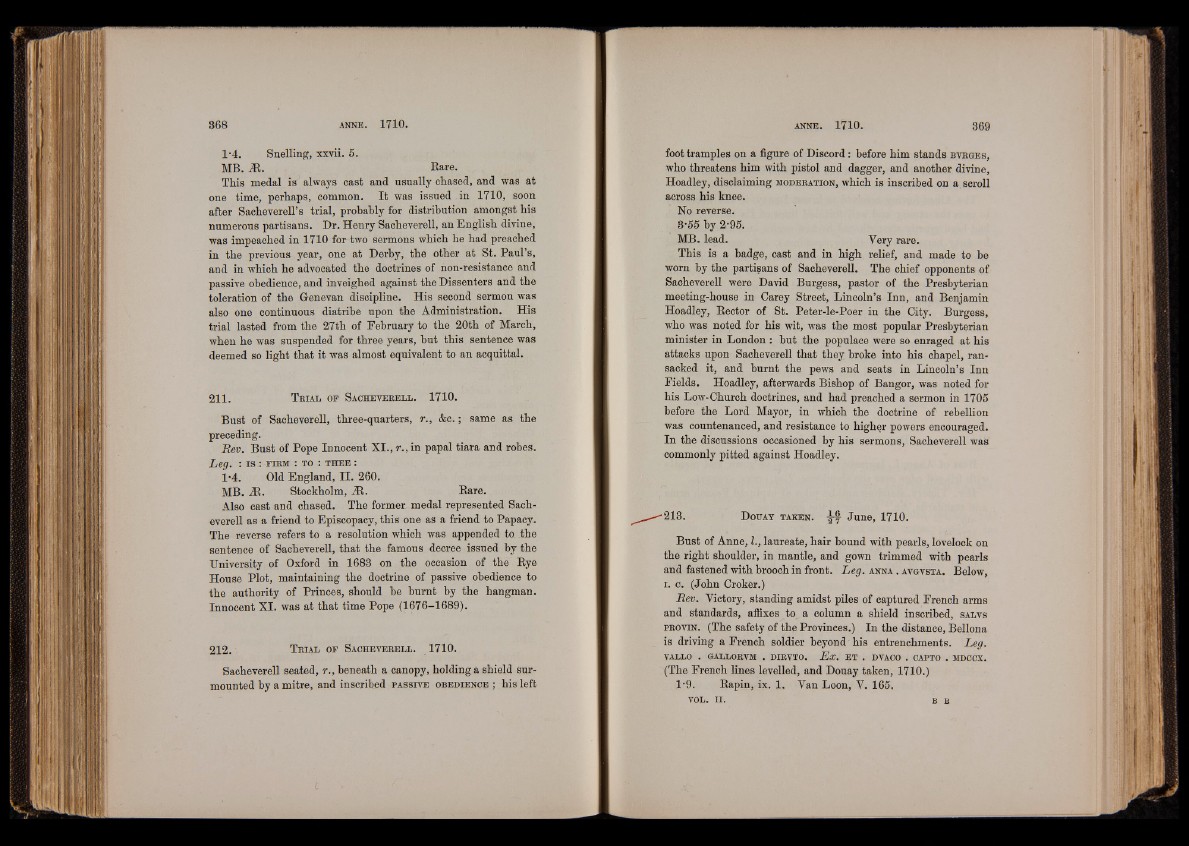
1-4. Snelling, xxvii. 5.
MB. iR. Rare.
This medal is always cast and usually chased, and was at
one time, perhaps, common. It was issued in 1710, soon
after Sacheverell’s trial, probably for distribution amongst his
numerous partisans. Dr. Henry Sacheverell, an English divine,
was impeached in 1710 for two sermons which he had preached
in the previous year, one at Derby, the other at St. Paul’s,
and in which he advocated the doctrines of non-resistance and
passive obedience, and inveighed against the Dissenters and the
toleration of the Genevan discipline. His second sermon was
also one continuous diatribe upon the Administration. His
trial lasted from the 27th of February to the 20th of March,
when he was suspended for three years, but this sentence was
deemed so light that it was almost equivalent to an acquittal.
211. T r ia l o p S a c h e v e r e l l . 1710.
Bust of Sacheverell, three-quarters, r., &c.; same as the
preceding.
Rev. Bust of Pope Innocent XI., r., in papal tiara and robes.
Leg. : i s p i rm : to : t h e e :
1-4. Old England, II. 260.
MB. 2R. Stockholm, HI. Rare.
Also cast and chased. The former, medal represented Sacheverell
as a friend to Episcopacy, this one as a friend to Papacy.
The reverse refers to a resolution which was appended to the
sentence of Sacheverell, that the famous decree issued by the
University of Oxford in 1683 on the occasion of the Rye
House Plot, maintaining the doctrine of passive obedience to
the authority of Princes, should be burnt by the hangman.
Innocent XI. was at that time Pope (1676-1689).
212. T r ia l o p S a c h e v e r e l l . 1710.
Sacheverell seated, r., beneath a canopy, holding a shield surmounted
by a mitre, and inscribed pa s s iv e o b e d ie n c e ; his left
ANNE
foot tramples on a figure of Discord: before him stands b v r g e s ,
who threatens him with pistol and dagger, and another divine,
Hoadley, disclaiming m o d e r a t io n , which is inscribed on a, scroll
across his knee.
No reverse.
3-55 by 2-95.
MB. lead. Very rare.
This is a badge, cast and in high relief, and made to be
worn by the partisans of Sacheverell. The chief opponents of
Sacheverell were David Burgess, pastor of the Presbyterian
meeting-house in Carey Street, Lincoln’s Inn, and Benjamin
Hoadley, Rector of St. Peter-le-Poer in the City. Burgess,
who was noted for his wit, was the most popular Presbyterian
minister in London : but the populace were so enraged at his
attacks upon Sacheverell that they broke into his chapel, ransacked
it, and burnt the pews and seats in Lincoln’s Inn
Fields. Hoadley, afterwards Bishop of Bangor, was noted for
his Low-Church doctrines, and had preached a sermon in 1705
before the Lord Mayor, in which the doctrine of rebellion
was countenanced, and resistance to higher powers encouraged.
In the discussions occasioned by his sermons, Sacheverell was
commonly pitted against Hoadley.
Douay t a k e n ,
Bust of Anne, I., laureate, hair bound with pearls, lovelock on
the right shoulder, in mantle, and gown trimmed with pearls
and fastened with brooch in front. Leg. anna . avgvsta. Below,
i. c. (John Croker.)
Rev. Victory, standing amidst piles of captured French arms
and standards, affixes to a column a shield inscribed, sal vs
p r o v in . (The safety of the Provinces.) In the distance, Bellona
is driving a French soldier beyond his entrenchments. Leg.
VALLO . GALLORVM . DIRVTO. Ex. ET . DVACO . CAPTO . MDCCX.
(The French lines levelled, and Douay taken, 1710.)
l -9. Rapin, ix. 1. Van Loon, V. 165.
VOL. I I. B B